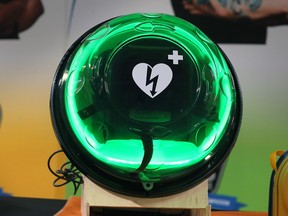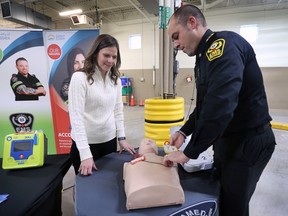Article content
For Andrea Ducharme and her children, scouring the region for publicly accessible defibrillators has been a fun activity.
Article content
But for Essex-Windsor EMS, which asked earlier this year for the public’s help locating and advising it of where all those locally available emergency medical devices are located, it’s a matter of life and death.
“When someone suffers cardiac arrest, the chance of survival decreases every minute that CPR and defibrillation is not applied,” Justin Lammers, chief of Essex-Windsor EMS, told reporters Monday.
Article content
“Much like smoke detectors help give people a chance to escape before firefighters arrive, AEDs allow members of the public to start assisting someone suffering cardiac arrest while our paramedics are on the way.”
AEDs, or automated external defibrillators, are simple-to-use machines used to help a person whose heart has stopped functioning. The machine gives step-by-step voice instructions, telling the user how to check for breathing and a pulse, and how and where to place the AED pads on a person’s chest.
Through those pads, it delivers a shock to restore normal heart rhythm.

In February, EMS launched PulsePoint, a smartphone app that lets people upload photos of AEDs and mark their locations on a map. Essex-Windsor EMS then verifies the information and publishes it on the publicly available map.
Most importantly, the information is shared with ambulance communications officers, those who take 911 calls and dispatch paramedics. They can tell 911 callers exactly where the nearest AED is and how to use it while they wait for paramedics to arrive.
So far, more than 1,000 AEDs have been mapped across Windsor and Essex County.
Article content
Tecumseh resident Ducharme and her kids, ages eight, 11, and 13, have been keeping an eye out for AEDs. Using the PulsePoint app on Ducharme’s phone, they’ve mapped out 22 over the last eight months, more than any other single app user.
“My son is in travel hockey. There are a lot of arenas involved in that, and there are AEDs in every arena,” Ducharme said. She also saw AEDs inside the public schools where she works and at shopping centres.
“It was a fun activity for me and my kids to go through,” she said. “It’s something so easy to do that can help a lot of people — it takes 30 seconds.
“It’s not hard and it can save lives.”

In 2023, local AEDs were used 11 times to help people experiencing cardiac arrest. Last June, a device saved the life of a 61-year-old man playing racquetball at the Caboto Club. By the time EMS arrived, the man had resumed consciousness.
“This initiative matters a lot for our community,” said Lammers. “We’re doing everything we can to get ambulances to a patient’s side as quick as we can. But at the end of the day, there’s going to be a period of time that it takes for the recognition of a cardiac arrest, phoning 911, the assignment of resources, paramedics’ drive time — all of those minutes are valuable.”
Recommended from Editorial
Residents, church groups, business owners, and others interested in purchasing an AED can contact Essex-Windsor EMS at defib@countyofessex.ca for more information. The devices can cost $2,000 or more.
EMS also offers free AED and CPR awareness sessions. Those can be booked by visiting countyofessex.ca/aed.
Share this article in your social network






